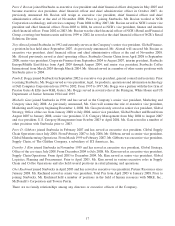Starbucks 2008 Annual Report Download - page 29
Download and view the complete annual report
Please find page 29 of the 2008 Starbucks annual report below. You can navigate through the pages in the report by either clicking on the pages listed below, or by using the keyword search tool below to find specific information within the annual report.Significant Actions Taken in Fiscal 2008
The more significant actions taken by Starbucks in fiscal 2008 to transform and reinvigorate its business included:
• A plan to close approximately 600 underperforming Company-operated stores in the US market, of which
205 were closed as of fiscal year-end with the remaining stores to be closed by the end of fiscal 2009;
• Restructuring the Company’s Australia business by closing 61 Company-operated stores, focusing on the
remaining 23 stores in three key metro areas;
• Reducing approximately 1,000 open and filled positions within the Company’s leadership structure and its
non-store organization, to rationalize its infrastructure for the reduced number of stores; and
• Introducing new beverage platforms designed to reinvigorate the Starbucks beverage offerings, new
breakfast food offerings and bakery and chilled foods, including health and wellness choices, and a
new, everyday brewed coffee, Pike Place
TM
Roast, which returned the Company to the practice of grinding
whole beans in stores and brewing every 30 minutes to provide customers with the freshest coffee possible.
Fiscal 2009 — The View Ahead
Management expects the Company to continue to face a very difficult economic environment throughout fiscal
2009, both in the US and internationally, including in its two largest Company-operated markets of Canada and the
UK. As the global financial crisis has broadened and intensified, other sectors of the global economy have been
adversely impacted and a severe global recession of uncertain length now appears likely. As a retailer that is
dependent upon consumer discretionary spending, the Company expects to face an extremely challenging fiscal
2009 because of these economic conditions. Accordingly, Starbucks expects to report negative comparable store
sales for fiscal 2009. Additionally, the Company’s earnings for fiscal 2009 will be impacted by lease termination
and severance costs from the US and Australia store closures, totaling up to an estimated $0.12 of EPS for fiscal
2009. The Company estimates that the combination of the US and Australia store closures and head count
reductions will result in a pre-tax benefit to operating income of approximately $200 million to $210 million in
fiscal 2009, which equates to approximately $0.17 to $0.18 of EPS.
Starbucks plans to be disciplined in its approach to new store openings, in both Company-operated and licensed
markets, and adjust as needed in response to further worsening in the global economy. Starbucks fiscal 2009 US
store opening target is approximately a negative 20 net new stores, which includes a nearly 225 Company-operated
store decline and approximately 205 net new licensed stores. Internationally, Starbucks is planning to open
approximately 700 net new stores in fiscal 2009, two-thirds of which are expected to be licensed, as it factors in the
current global economic climate, with a more cautious approach in the UK and western Europe.
Operating Segment Overview
Starbucks has three reportable operating segments: United States, International and CPG.
The United States and International segments both include Company-operated retail stores, licensed retail stores
and foodservice operations. Licensed stores frequently have a higher operating margin than Company-operated
stores. Under the licensed model, Starbucks receives a reduced share of the total store revenues, but this is more than
offset by the reduction in its share of costs as these are primarily borne by the licensee. The International segment
has a higher relative share of licensed stores versus Company-operated compared to the US segment; however, the
US segment has been operating significantly longer than the International segment and has developed deeper
awareness of, and attachment to, the Starbucks brand and stores among its customer base. As a result, the more
mature US segment has significantly more stores, and higher total revenues than the International segment. Average
sales per store are also higher in the US due to various factors including length of time in market and local income
levels. Further, certain market costs, particularly occupancy costs, are lower in the US segment compared to the
average for the International segment, which comprises a more diverse group of operations. As a result of the
relative strength of the brand in the US segment, the number of stores, the higher unit volumes, and the lower market
costs, the US segment, despite its higher relative percentage of Company-operated stores, has a higher operating
margin, excluding restructuring costs, than the less-developed International segment.
23
























